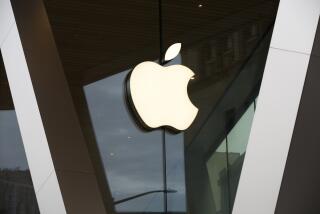Apple heads into annual showcase reeling from AI missteps, tech upheaval and Trump’s trade war

- Share via
CUPERTINO, Calif. — After stumbling out of the starting gate in Big Tech’s pivotal race to capitalize on artificial intelligence, Apple will try to regain its footing Monday at its annual Worldwide Developers Conference.
The presummer rite, which attracts thousands of developers to Apple’s Silicon Valley headquarters, is expected to be more subdued than the feverish anticipation that surrounded the event during the previous two years.
In 2023, Apple unveiled a mixed-reality headset that has been little more than a niche product, and last year the developers conference trumpeted its first major foray into AI with an array of new features highlighted by the promise of a smarter and more versatile version of its virtual assistant, Siri.
Apple had intended the planned Siri upgrade to herald its long-awaited attempt to become a major player in the AI craze after getting a late start in a phenomenon that so far has been largely led by OpenAI, Google, Microsoft and an array of cutting-edge startups.
Instead, as Apple heads into this year’s showcase, the company faces nagging questions about whether the nearly 50-year-old company has lost some of the mystique and innovative drive that turned it into a tech trendsetter. Instead of making a big splash as it did with the Vision Pro headset, Apple this year is expected to focus on an overhaul of its software that may include a new, more tactile look for the iPhone’s native apps and a new nomenclature for identifying its operating system updates.
Even though it might look as though Apple is becoming a technological laggard, Forrester Research analyst Thomas Husson contends the company still has ample time to catch up in an AI race that’s “more of a marathon, than a sprint. It will force Apple to evolve its operating systems.”
If reports about its iOS naming scheme pan out, Apple will switch to a method that automakers have used to telegraph their latest car models by linking them to the year after they first arrive at dealerships. That would mean the next version of the iPhone operating system due out this autumn will be known as iOS 26 instead of iOS 19 — as it would be under the current sequential naming approach.
Whatever it’s named, the next iOS will likely be released as a free update in September, around the same time as the next iPhone models if Apple follows its usual road map.
Meanwhile, Apple’s references to AI may be less frequent than last year when the technology was the main attraction.
Although some of the new AI tricks compatible with the latest iPhones began rolling out late last year as part of free software updates, Apple still hasn’t been able to soup up Siri in the ways that it touted at last year’s conference. The delays became so glaring that a chastened Apple retreated from promoting Siri in its AI marketing campaigns earlier this year.
“It’s just taking a bit longer than we thought,” Chief Executive Tim Cook told analysts last month when asked about the company’s headaches with Siri. “But we are making progress, and we’re extremely excited to get the more personal Siri features out there.”
While Apple has been struggling to make AI that meets its standards, the gap separating it from other tech powerhouses is widening. Google keeps packing more AI into its Pixel smartphone lineup while introducing more of the technology into its search engine to dramatically change the way it works. Samsung, Apple’s biggest smartphone rival, is also leaning heavily into AI. Meanwhile, ChatGPT recently struck a deal that will bring former Apple design guru Jony Ive into the fold to work on a new device expected to compete against the iPhone.
“While much of WWDC will be about what the next great thing is for the iPhone, the unspoken question is: What’s the next great thing after the iPhone?” said Dipanjan Chatterjee, another analyst for Forrester Research.
Besides facing innovation challenges, Apple also faces regulatory threats that could siphon away billions of dollars in revenue that help finance its research and development. A federal judge is weighing whether proposed countermeasures to Google’s illegal monopoly in search should include a ban on long-running deals worth $20 billion annually to Apple, and another federal judge recently banned the company from collecting commission on in-app transactions processed outside its once-exclusive payment system.
On top of all that, Apple has been caught in the crosshairs of President Trump’s trade war with China, a key manufacturing hub for the Cupertino, Calif., company. Cook successfully persuaded Trump to exempt the iPhone from tariffs during the president’s first administration, but he has had less success during Trump’s second term, which seems more determined to prod Apple to make its products in the U.S.
“The trade war and uncertainty linked to the tariff policy is of much more concern today for Apple’s business than the perception that Apple is lagging behind on AI innovation,” Husson said.
The multidimensional gantlet facing Apple is spooking investors, causing the company’s stock price to plunge by nearly 20% this year — a decline that has erased $750 billion in shareholder wealth. After beginning the year as the most valuable company in the world, Apple now ranks third behind longtime rival Microsoft, another AI leader, and AI chipmaker Nvidia.
Liedtke writes for the Associated Press.
More to Read
Inside the business of entertainment
The Wide Shot brings you news, analysis and insights on everything from streaming wars to production — and what it all means for the future.
You may occasionally receive promotional content from the Los Angeles Times.










